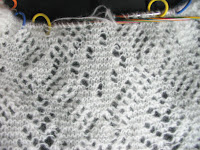Well, I put the shawl down, got distracted by fireworks and didn't get back to it for a couple of days. Checking to see where I left off my row counters greeted me with this:
It looks more complicated than it is. This is one of the points where the edge charts deviate from the same number rows, at the end/beginning of the repeats. Chart B1, represented by the black counter, is on the second row of the repeating rows 15-30 and Chart B2, represented by the blue counter, is on the penultimate row of the repeating rows18-33. Short rows will soon have the counters reading the same numbers again. I'm repeating the row numbers on the counters because I have young children in the house and the frequent interruptions they create. The knitting itself keeps track of the number of repeats I've knit, so I only really need to know where I am in the moment.

Which got me to thinking about how many things are so much harder to describe or explain than they are to actually do. I've felt that in describing the process of working through this shawl. While this is not a project for beginners, the actual knitting is very straightforward. There are no terribly complicated stitches. The entire effect is created by yarn overs and knit 2 together. There are occasional knit 3 togethers. No ssk, psso, nupps or other stitch juggling. No purls. It bears repeating: no purls. The design is economical and very elegant, and is almost supernaturally suited to the yarn. This Superior is such a dream to work with, I feel badly for calling it sticky in my last post. I didn't mean that in a bad way. The halo is unbelievable, unlike anything I've knit with before and this is a perfectly natural way for the fiber to behave. I think part of the reason Orenburg shawls have such mystique, aside from their obvious beauty, is the glorious marriage of fiber to design. They complement each other so perfectly.
The effect is quite different in a different yarn. Since I didn't really document the tricky first corner very well, I decided to go back and do it again, in a smoother yarn so the stitches would be clearer. I think there are people who'd like to knit this and start reading the pattern and get intimidated. It's well worth tackling and it would be a shame for people not to knit it because of that. So I'd like to talk about the process of getting this established on your needles. Once that is done, knitting up to the top edge is a simple matter of keeping track of where you are.
So, it begins with a provisional cast on:
Here I used a simple backwards loop. I may have done a more complicated crochet cast on where I picked up the stitches in the back of the chain for the shawl, but I think the main difference that makes is that it's harder to remove. So this time I kept it simple. Once you've cast on, you switch to your main color yarn and begin knitting Chart A.
Here is the provisional cast on with the first few rows of Chart A.
And here is Chart A completed:
You can see already that this yarn doesn't look nearly as beautiful as the Superior. Some lace patterns look lovely knit in larger yarns, but this design is so well suited to the very fine cashmere originally spun in Orenburg that the design is far less effective in this cotton. There may be other fibers that would work, but if you've ever swatched a yarn to Rhinebeck and back trying to figure out what it was meant to be, you know how important yarn choice is to the successful execution of some patterns.
The next step is picking up stitches along the row seen here at the top, which form the stitches at the base of Chart C:
You can (sort of) see the red marker I placed to separate the stitches for the edge from the picked up stitches.
This picture shows the result of 2 steps:
I have knit the first row of Chart C, knit 1, knit 2 together, and placed a purple marker.
With the other needle I've picked up the stitches of the provisional cast on
and proceed to knit across them:
Actually I have to admit that I think there's a slight counting mistake in the pattern. The original cast on is 11 stitches, but both times I've gone back to pick up these stitches there have been 10. The first time I thought it was me, double checked that nothing was dropped, cast my fate to the adhesive qualities of this yarn and just made one to have the right amount of stitches on the needle. (Shhhh!) The second time I figured out that the 11th stitch has been absorbed into the stitches between the markers. So you will need to make one stitch to have the right number for the left edge chart.
The provisional cast on is visible below the needle to the left of the purple marker. The fabric is stretched to pull the curved edge onto the straight needle.
Now it's time to begin knitting across all 3 charts, row "b" back to the right edge. At this point the provisional cast on is removed.
The first 15-18 rows of the edge charts contain more short rows to create the corner. This is why there are so many fewer rows of Chart C shown in the zig zaggy chart above Chart A.
This shows the knitting about halfway through the first edge charts. The fabric is no longer stretched.
This last photo shows Chart A in the middle on the bottom corner, the first repeats of the edge charts and chart C to row 8 in the middle at the top between the stitch markers.
After you've knit to this point you're knitting short rows on the edges every 5th row and otherwise it's back and forth.
I'm sure the top corners will be another adventure in engineering with short rows and I'll be sure to document that more carefully the first time I knit through it.
 First up is #64 Saone, by Tina Hees from our "On The Street" collection of fall cardigans and jackets. It's a very versatile, wearable design in a lovely angora/silk yarn. The lines are clean and straightforward, with crisp narrow ribs adding interest. But what's easy to miss unless you really stop and examine the picture is the cabled button band, which frames the buttons and adds a feminine touch of curve to this crisp design. I knit up a swatch with button bands on either end to feature this lovely detail.
First up is #64 Saone, by Tina Hees from our "On The Street" collection of fall cardigans and jackets. It's a very versatile, wearable design in a lovely angora/silk yarn. The lines are clean and straightforward, with crisp narrow ribs adding interest. But what's easy to miss unless you really stop and examine the picture is the cabled button band, which frames the buttons and adds a feminine touch of curve to this crisp design. I knit up a swatch with button bands on either end to feature this lovely detail. I couldn't get my hands on Julia, the recommended yarn for the project, but I did happen to have a skein of Valley Yarns' Deerfield in Sweet Pea, which has the same 80% angora/20% silk blend. This is a wonderful soft yarn that I really enjoyed knitting up. It has a subtle halo from the angora and a sheen from the silk. Stitch definition is excellent, I think it would make a good alternative for those in the US who don't have access to the recommended yarn.
I couldn't get my hands on Julia, the recommended yarn for the project, but I did happen to have a skein of Valley Yarns' Deerfield in Sweet Pea, which has the same 80% angora/20% silk blend. This is a wonderful soft yarn that I really enjoyed knitting up. It has a subtle halo from the angora and a sheen from the silk. Stitch definition is excellent, I think it would make a good alternative for those in the US who don't have access to the recommended yarn.




























 I would recommend, for anyone who hasn't gotten to row 114 yet that you make a note, or a mark to alert you when the time comes. Or just pay more attention than I did and never assume.
I would recommend, for anyone who hasn't gotten to row 114 yet that you make a note, or a mark to alert you when the time comes. Or just pay more attention than I did and never assume. 



















